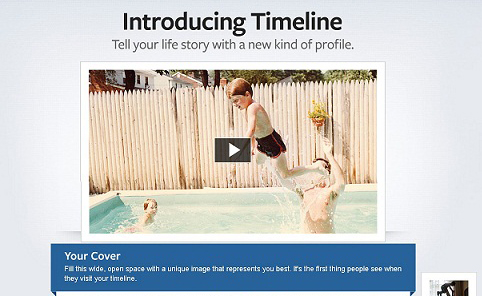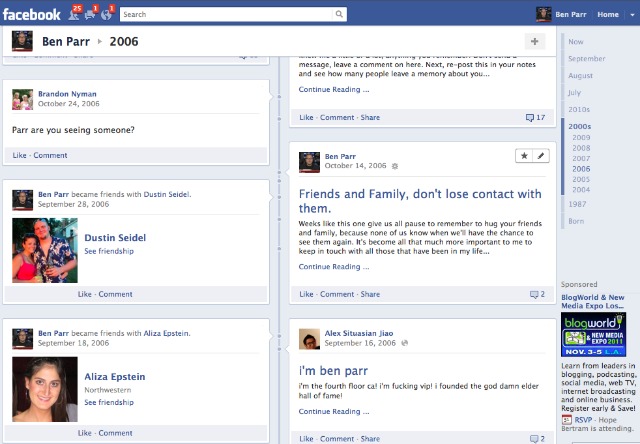How Facebook is Turning Us All Into Bloggers
When Facebook introduced some of its new features a week or so ago, there was general complaining all around. People hated the Ticker and the blue tags on “most interesting” posts. But that wasn’t the end of the changes. Some of you know that yet another feature is coming down the pipe: a completely redesigned profile, called Timeline.
It gives you two columns of Wall posts and a big, beautiful cover image behind your profile pic. This look says a lot about a strategy Facebook is adopting: to turn every user’s profile into a unique, Facebook-sanctioned blog. With a collection of 800 million “bloggers”, Facebook is steadily building itself into an insulated version of the Internet, rich with personal info to apply to advertising.
Since I started this site back in April, I’ve embraced blogging wholeheartedly. This has led me to see similarities between the design of Facebook’s Timeline and the format of my own site. It's clear that Facebook sees itself as being the big brother (note the word choice there) to established blogging platforms like WordPress and Blogspot. Not only does Facebook give you your own “blog”, or profile, but they offer all the sharing and networking you love.
The first thing I thought of when I saw the space for the new cover image was the header photo on many blogs. It spreads across the top of the page, a banner of individualization for your profile. It encourages more people to view each other’s profiles and browse through the posts below in the timeline. Each profile becomes a blog of sorts, nestled safely under the big blue umbrella of Facebook. (Curious about how to activate Timeline early? Check out this Mashable article for the guide!)
The flow of the Timeline itself is another indicator of the Facebook’s blog-inspired layout. There are now two columns of stories, wrapped in tidy little boxes that are reminiscent of daily (or hourly) article posts on blogs. The columns are linked to the eponymous timeline, flowing chronologically back to when you first joined Facebook. Instead of fleeting little status updates that all look the same when stacked together, Timeline makes each tidbit pop, as if meant to be picked out by new “readers” exploring your life story.
This is no sudden policy change for Facebook. In a way, the company has been making little changes here and there for a long time that each made profiles more like individual blogs. One was the Notes feature. Users wrote Notes like little blog posts, musing about their day or writing opinion pieces about pet peeves.
Another update was Facebook’s decision to give every user a customizable domain name for their profiles. The idea was to make profiles easier to find; instead of a long string of letters and numbers, you could choose something like “facebook.com/firstname.lastname”. Even in this small way, Facebook helped users “brand” their profiles – make them easy to remember and share.
Is this “blog-erization” a bad thing? Not necessarily. After all, Facebook is still a community restricted to its own users. Unless you decide to make your profile/blog completely visible to the public, the only people who will become regular readers of your Facebook blog are those you’ve added as friends.
Admittedly, a limited number of people use Facebook in a way that would turn their profiles into proper blogs: sharing links and writing long-form status updates. Nevertheless, what Facebook’s really doing by turning profiles into pseudo-blogs is to reproduce the Internet within the walls of Facebook itself.
How? You can already watch YouTube in embedded form in your News Feed, and see people’s tweets piped in from Twitter. Facebook’s partnerships with Spotify and Skype aim to expand the sharing capabilities of the site. As I've explained, the profiles are the blogs of the Facebook Internet, hosting individual opinions and content. In this way, the whole network acts like a colossal filter, keeping traffic within Facebook and interacting with Facebook’s main source of revenue: advertising.
The more users stay within the Facebook version of the Internet, and the more they update their profile blogs, Facebook simultaneously gathers more information to tailor their ads for more effective targeting. Even though tech writers are currently crying foul over purported browser tracking, I think Facebook’s business strategy is more visible in its new profile design. Think about it – 800 million bloggers filling little mini-sites with likes, dislikes and glimpses (if not full access) into their real lives.
To put that number is perspective, blog search engine BlogPulse.com, as of this writing, has identified over 172 million individual blogs, of which almost 105,000 were created in the last 24 hours. As Facebook rolls out the new look, there is suddenly almost a billion blogs online.
It’s not that the huge surplus of new blogs would overshadow the existing ones, but that the new blogs are contained within this huge Facebook version of the Internet, exerting more influence than the “unaffiliated” blogs of the past.
Let me be clear: I won’t be ditching Facebook over this. I actually like the new look of the profiles. They’re clean, easier to navigate, and personalized. I simply want to call attention to what the profile design says about Facebook, and what we may be unconsciously participating in by choosing flashy cover images or sifting through the Timelines of friends. Our profiles are more powerful than ever before, and I believe it’s a power Facebook wants to harness.
-
What do you think about this idea? Am I right in drawing a connection between the new profiles and the blog format? Am I crazy? Share your reaction in the comments section below, and catch up on some of my related Internet culture commentary:





